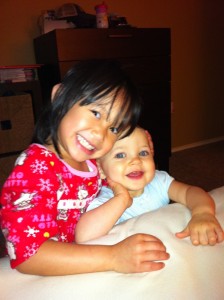When you are around Tapestry, you hear the word expectations thrown around a lot. I think I’ve been pretty confident that my expectations are right on, no problems here. Until Elise started getting older and acquiring more language and things started getting interesting.
We adopted Elise when she was 6 months old, so I felt like we got her home as young as we could. My husband and I split staying home with her for the first three months to make that initial attachment, and then we just showered her with as much attention and love as we could give.
When Elise was 18 months old we attended an Empowered to Connect training, so we could learn about parenting a child from a hard place. At that time, Elise was not doing any behaviors that were disrupting our family unit. She didn’t like to run errands after school even when I tried wearing her in a carrier. But that was an easy fix, my husband just took over the grocery shopping and saved my errands for the weekend while Elise and I got to reconnect from our time apart. During the training, we were told several times that the other parents wished they had learned about Empowered to Connect when their kids were younger instead of already in elementary school. So again, I thought we will be fine since we know this stuff so much earlier than everyone else. And we were fine.
Now, when I reflect back on our oldest as a baby, sleep was always the most stressful thing for us. It would take an hour to hour and a half each night to get Elise to sleep. And when she woke up in the middle of the night, she usually woke up screaming. We stayed in her room or laid down with her until she fell asleep until she was about two and a half. So, it wasn’t terrible, but it was always met with some level of stress and work.
It’s only now having a newborn turned 5 month old in the house that I realize we missed a lot by not having Elise until she was 6 months old. It was pretty naïve of me to think that our daughter wouldn’t have any effects from living in an orphanage for 6 months. Our five month old, Maggie, knows who we are. She smiles when we come in a room; she babbles to us. She’s relaxed and at ease at bedtime, and when she wakes up in the middle of the night, which is a stark contrast to how our oldest went to sleep. (Now you could explain this away as personality or something else, but I live with my children. And Elise tells me often she is scared when she is by herself.)
When we brought Elise home, she smiled some, but for the most part she was silent. Two strangers came and took her from her familiar surroundings, and then we took her on a 16 hour airplane trip and brought her “home” to Plano, TX. (It’s her home now, but at the time, it was not home to her. Everything was foreign to her.) So, it’s no wonder she just stared at us with those big brown eyes, and it’s no wonder sleep was a stressful time for her. We didn’t know the tricks she had or had not learned, and we certainly didn’t have her in a familiar room. We always turned out the lights, but I have no idea how dark or warm or cold her room in at the orphanage was. So while we had the training and were prepared for the worst, when she seemed “fine” we didn’t make any extra efforts or exceptions until she started pushing back.
So in May of 2011 when we had Maggie, we turned Elise’s world upside down, and she didn’t know what each day was going to bring. Life became very unpredictable for Elise. And the transition has been tough on everyone. We are now five months into being parents of two children, and we are still trying to get our 3 year old back to where she was before Maggie came. We don’t have severe issues, but we deal with our share of anxiety, fear, stress, and lack of sleep which seems to present itself as long periods of crying/screaming and renewed dislike for separation. We battled for four months until we remembered our Empowered to Connect training and started looking for ways we could support Eilse instead of giving in to frustration all the time. And as we have become more consistent and comfortable in our role as parents of two children, she has been able to relax and smile and laugh more. Now we are not perfect, we are currently working on getting our oldest more attuned to what her body is telling her and how she’s feeling, so she can recognize when she’s tired, hungry, or needs attention.
At the same time life became unpredictable, Elise started processing more of her story. We’ve read her lifebook several times, and she’s familiar with the words adoption and Vietnam. But she had never asked questions. Now she asks, “Was I in your tummy?” “Are you adopted?” “Where is my birthmom?” “Do my birthparents miss me?” I asked that last question back to her and her response was, “I think yes because I’m gone.” That’s true. She is gone from Vietnam. She was this cute little baby that had already suffered the loss of her birth family and then suffered more loss when she left her caretakers at the orphanage, and that’s sad. It makes me sad that she has to process those questions and that I don’t have all the answers for her. But she quickly moves on to bouncing around until she can hear the contents of her stomach sloshing around or something while I’m still stewing over her sadness. In essence, it’s normal to her to think about those things; she doesn’t know any different. But I know it can be different, and it is different for our youngest daughter.
So I think, I dutifully attended all the trainings and read all the books, but I never really expected to deal with the issues everyone else was. I never expected it to be such hard work. Other adoptive families had major things going on in their families, and from our perspective, if we had any they were mild. But though they may be mild in their frequency, they feel major when you’re going through it. And I have to deal with my perception of things and not project my feelings into what my oldest daughter is processing. When we have problems or normal adoption stuff (like the questions about birth parents), we have a way to address them because of Tapestry and Empowered to Connect. I can’t imagine where we would be with that – no where good.
 I want to read enough, study enough so I can ace parenting. The more I research and give myself; the more Elise pushes back with her emotions. When she says, “Nobody loves me…will you still love me forever…will you be here in the morning,” it feels like failure. It feels like all the work I’ve done and knowledge I’ve gained on attachment and parenting isn’t working. I feel defeated, but I can’t give up. I think maybe the next ten times I say I love you and reassure her of my stability will be enough. But maybe she will come back with her concerns, and it will feel like failure again. I think the feeling of failure stems from the lack of control I feel.
I want to read enough, study enough so I can ace parenting. The more I research and give myself; the more Elise pushes back with her emotions. When she says, “Nobody loves me…will you still love me forever…will you be here in the morning,” it feels like failure. It feels like all the work I’ve done and knowledge I’ve gained on attachment and parenting isn’t working. I feel defeated, but I can’t give up. I think maybe the next ten times I say I love you and reassure her of my stability will be enough. But maybe she will come back with her concerns, and it will feel like failure again. I think the feeling of failure stems from the lack of control I feel.

